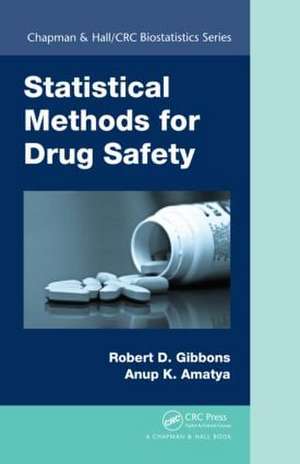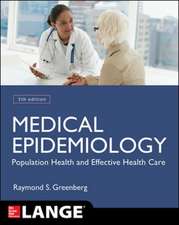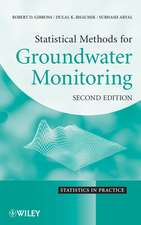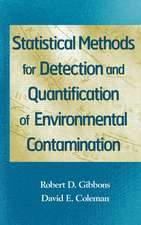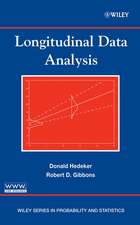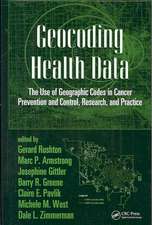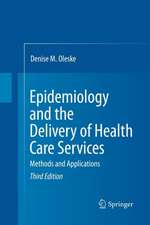Statistical Methods for Drug Safety: Chapman & Hall/CRC Biostatistics Series
Autor Robert D. Gibbons, Anup Amatyaen Limba Engleză Hardback – 21 iul 2015
Statistical Methods for Drug Safety presents a wide variety of statistical approaches for analyzing pharmacoepidemiologic data. It covers both commonly used techniques, such as proportional reporting ratios for the analysis of spontaneous adverse event reports, and newer approaches, such as the use of marginal structural models for controlling dynamic selection bias in the analysis of large-scale longitudinal observational data.
Choose the Right Statistical Approach for Analyzing Your Drug Safety Data
The book describes linear and non-linear mixed-effects models, discrete-time survival models, and new approaches to the meta-analysis of rare binary adverse events. It explores research involving the re-analysis of complete longitudinal patient records from randomized clinical trials. The book discusses causal inference models, including propensity score matching, marginal structural models, and differential effects, as well as mixed-effects Poisson regression models for analyzing ecological data, such as county-level adverse event rates. The authors also cover numerous other methods useful for the analysis of within-subject and between-subject variation in adverse events abstracted from large-scale medical claims databases, electronic health records, and additional observational data streams.
Advance Statistical Practice in Pharmacoepidemiology
Authored by two professors at the forefront of developing new statistical methodologies to address pharmacoepidemiologic problems, this book provides a cohesive compendium of statistical methods that pharmacoepidemiologists can readily use in their work. It also encourages statistical scientists to develop new methods that go beyond the foundation covered in the text.
| Toate formatele și edițiile | Preț | Express |
|---|---|---|
| Paperback (1) | 299.15 lei 6-8 săpt. | |
| CRC Press – 21 ian 2023 | 299.15 lei 6-8 săpt. | |
| Hardback (1) | 557.58 lei 6-8 săpt. | |
| CRC Press – 21 iul 2015 | 557.58 lei 6-8 săpt. |
Din seria Chapman & Hall/CRC Biostatistics Series
-
 Preț: 386.63 lei
Preț: 386.63 lei - 5%
 Preț: 338.18 lei
Preț: 338.18 lei - 5%
 Preț: 656.97 lei
Preț: 656.97 lei -
 Preț: 341.43 lei
Preț: 341.43 lei -
 Preț: 355.92 lei
Preț: 355.92 lei - 8%
 Preț: 432.16 lei
Preț: 432.16 lei -
 Preț: 354.78 lei
Preț: 354.78 lei -
 Preț: 342.90 lei
Preț: 342.90 lei -
 Preț: 288.81 lei
Preț: 288.81 lei -
 Preț: 312.36 lei
Preț: 312.36 lei - 9%
 Preț: 644.58 lei
Preț: 644.58 lei - 8%
 Preț: 376.64 lei
Preț: 376.64 lei -
 Preț: 372.30 lei
Preț: 372.30 lei -
 Preț: 356.64 lei
Preț: 356.64 lei - 8%
 Preț: 531.51 lei
Preț: 531.51 lei - 9%
 Preț: 608.33 lei
Preț: 608.33 lei - 9%
 Preț: 766.28 lei
Preț: 766.28 lei -
 Preț: 378.12 lei
Preț: 378.12 lei -
 Preț: 356.64 lei
Preț: 356.64 lei - 9%
 Preț: 682.94 lei
Preț: 682.94 lei - 9%
 Preț: 594.80 lei
Preț: 594.80 lei -
 Preț: 311.47 lei
Preț: 311.47 lei -
 Preț: 362.08 lei
Preț: 362.08 lei - 9%
 Preț: 833.75 lei
Preț: 833.75 lei - 9%
 Preț: 683.12 lei
Preț: 683.12 lei - 9%
 Preț: 681.83 lei
Preț: 681.83 lei -
 Preț: 370.53 lei
Preț: 370.53 lei - 9%
 Preț: 940.39 lei
Preț: 940.39 lei - 18%
 Preț: 791.14 lei
Preț: 791.14 lei - 18%
 Preț: 702.37 lei
Preț: 702.37 lei - 18%
 Preț: 1730.31 lei
Preț: 1730.31 lei - 28%
 Preț: 875.16 lei
Preț: 875.16 lei - 18%
 Preț: 786.89 lei
Preț: 786.89 lei - 25%
 Preț: 825.63 lei
Preț: 825.63 lei - 15%
 Preț: 678.14 lei
Preț: 678.14 lei - 29%
 Preț: 625.83 lei
Preț: 625.83 lei - 18%
 Preț: 786.38 lei
Preț: 786.38 lei - 25%
 Preț: 778.07 lei
Preț: 778.07 lei - 25%
 Preț: 628.29 lei
Preț: 628.29 lei - 18%
 Preț: 1124.97 lei
Preț: 1124.97 lei - 28%
 Preț: 881.75 lei
Preț: 881.75 lei - 25%
 Preț: 526.81 lei
Preț: 526.81 lei - 18%
 Preț: 797.46 lei
Preț: 797.46 lei - 15%
 Preț: 479.86 lei
Preț: 479.86 lei - 18%
 Preț: 1017.63 lei
Preț: 1017.63 lei
Preț: 557.58 lei
Preț vechi: 743.90 lei
-25% Nou
Puncte Express: 836
Preț estimativ în valută:
106.71€ • 115.87$ • 89.63£
106.71€ • 115.87$ • 89.63£
Carte tipărită la comandă
Livrare economică 22 aprilie-06 mai
Preluare comenzi: 021 569.72.76
Specificații
ISBN-13: 9781466561847
ISBN-10: 146656184X
Pagini: 308
Ilustrații: 36 black & white illustrations, 50 black & white tables
Dimensiuni: 156 x 234 x 20 mm
Greutate: 0.73 kg
Ediția:1
Editura: CRC Press
Colecția Chapman and Hall/CRC
Seria Chapman & Hall/CRC Biostatistics Series
ISBN-10: 146656184X
Pagini: 308
Ilustrații: 36 black & white illustrations, 50 black & white tables
Dimensiuni: 156 x 234 x 20 mm
Greutate: 0.73 kg
Ediția:1
Editura: CRC Press
Colecția Chapman and Hall/CRC
Seria Chapman & Hall/CRC Biostatistics Series
Cuprins
Introduction. Basic Statistical Concepts. Multi-Level Models. Causal Inference. Analysis of Spontaneous Reports. Meta-Analysis. Ecological Methods. Discrete-Time Survival Models. Research Synthesis. Analysis of Medical Claims Data. Methods to Be Avoided. Summary and Conclusions. Bibliography. Index.
Recenzii
"Gibbons and Amatya’s book Statistical Methods for Drug Safety provides an overview of the core statistical methodology used in pharmacoepidemiology and drug safety. The authors draw on considerable experience in drug safety research to describe many of the key methods used in this field. The book is directed at two distinct groups of readers: statisticians with a good grasp of core concepts in applied statistics who are interested in pharmacoepidemiology, and pharmacoepidemiologists with a strong quantitative background who wish to learn more about the statistical tools in use in the field. Chapter 2 leads off with an overview of core statistical concepts used in epidemiology and clinical research. This brief section is very well done and helps orient the broad readership with a common language. This section would be helpful for either a nonstatistician needing an overview or for a statistician unfamiliar with some of the epidemiology-specific concepts used in the field. … The book is technically quite detailed and provides a solid grounding on each of the tools used. Many of the chapters could stand alone as a solid introduction to the area in question. …. This book would be a useful addition to the library of a drug safety researcher, whether a statistician or an epidemiologist, who is interested in the statistical methods underlying the field."
—Robert W. Platt, McGill University, in The American Statistician, October 2017
"With the growing emphasis and regulation of product safety evaluation and benefit–risk evaluation, the publication of this safety statistics book has been a great addition to the Chapman and Hall/CRC biostatistics series in 2015. Comparing to the other well-written books on quantitative evaluation of drug safety, this book focuses on the advanced statistical methodologies and practice in pharmacoepidemiologic problems. The book covers a wide variety of statistical methodologies to various types of drug safety data, including spontaneous adverse event reporting database, medical claim database, longitudinal observational studies, and randomized clinical trials (RCTs). Throughout these book chapters, real case studies on the safety evaluation, for which authors either have served as a statistical consultation or have done applied methodology research, have been used to illustrate the relevant methods. Their real experiences with their humorous and story-telling styles have made the reading captivating….Drug safety evaluation is becoming an international and increasingly important priority. As Bob Oneil pointed out, statistical methodology for safety monitoring has not been well developed to match that for efficacy. This book provides a great resource for a wide variety of statistical methods that are useful for pharmacoepidemiologists and safety physicians in their work. It should also motivate biostatisticians to innovate and contribute to this important field."
—William Wang in Journal of Biopharmaceutical Statistics, September 2016
—Robert W. Platt, McGill University, in The American Statistician, October 2017
"With the growing emphasis and regulation of product safety evaluation and benefit–risk evaluation, the publication of this safety statistics book has been a great addition to the Chapman and Hall/CRC biostatistics series in 2015. Comparing to the other well-written books on quantitative evaluation of drug safety, this book focuses on the advanced statistical methodologies and practice in pharmacoepidemiologic problems. The book covers a wide variety of statistical methodologies to various types of drug safety data, including spontaneous adverse event reporting database, medical claim database, longitudinal observational studies, and randomized clinical trials (RCTs). Throughout these book chapters, real case studies on the safety evaluation, for which authors either have served as a statistical consultation or have done applied methodology research, have been used to illustrate the relevant methods. Their real experiences with their humorous and story-telling styles have made the reading captivating….Drug safety evaluation is becoming an international and increasingly important priority. As Bob Oneil pointed out, statistical methodology for safety monitoring has not been well developed to match that for efficacy. This book provides a great resource for a wide variety of statistical methods that are useful for pharmacoepidemiologists and safety physicians in their work. It should also motivate biostatisticians to innovate and contribute to this important field."
—William Wang in Journal of Biopharmaceutical Statistics, September 2016
Notă biografică
Robert D. Gibbons, PhD, is a professor of biostatistics in the Departments of Medicine, Public Health Sciences, and Psychiatry and director of the Center for Health Statistics at the University of Chicago. He is a fellow of the American Statistical Association (ASA) and a member of the Institute of Medicine of the National Academy of Sciences. He has been a recipient of the ASA’s Outstanding Statistical Application Award and two Youden Prizes.
Anup Amatya, PhD, is an assistant professor in the Department of Public Health Sciences at New Mexico State University. His current research focuses on meta-analysis of sparse binary data and sample size determination in hierarchical non-linear models.
Anup Amatya, PhD, is an assistant professor in the Department of Public Health Sciences at New Mexico State University. His current research focuses on meta-analysis of sparse binary data and sample size determination in hierarchical non-linear models.
Descriere
This book presents a wide variety of statistical approaches for analyzing pharmacoepidemiologic data. It covers both commonly used techniques, such as proportional reporting ratios for the analysis of spontaneous adverse event reports, and newer approaches, such as the use of marginal structural models for controlling dynamic selection bias in the analysis of large-scale longitudinal observational data. Many real examples from both mental and physical health disorders illustrate the use of the methods.
